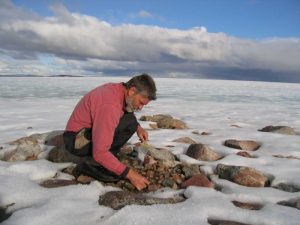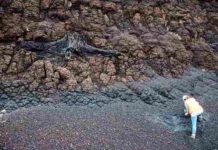
The last piece of the ice sheet that once blanketed much of North America is doomed to disappear in the next several centuries, says a new study by researchers at Simon Fraser University in British Columbia and the University of Colorado Boulder.
The Barnes Ice Cap, a Delaware-sized feature on Baffin Island in the Canadian Arctic, is melting at a rapid pace, driven by increased greenhouse gases in the atmosphere that have elevated Arctic temperatures. The ice cap, while still 500 meters thick, is slated to melt in about 300 years under business-as-usual greenhouse gas emissions.
The results provide compelling evidence that the current level of warming is almost unheard of in the past 2.5 million years, according to the authors. Only three times at most in that time period has the Barnes Ice Cap been so small, a study of isotopes created by cosmic rays that were trapped in rocks around the Barnes Ice Cap indicated.
“This is the disappearance of a feature from the last glacial age, which would have probably survived without anthropogenic greenhouse gas emissions,” said Adrien Gilbert, a glaciologist at Simon Fraser University in British Columbia in Canada and lead author of the new study published online today in Geophysical Research Letters, a journal of the American Geophysical Union.
While the melting of the Barnes Ice Cap will likely have negligible effects on sea level rise, its end could herald the eventual dissolution of the larger ice sheets like Greenland and Antarctica, said CU-Boulder Professor Gifford Miller, a study co-author.
“I think the disappearance of the Barnes Ice Cap would be just a scientific curiosity if it were not so unusual,” said Miller, the associate director of CU Boulder’s Institute of Arctic and Alpine Research who has conducted research on Baffin Island annually for the past five decades. “One implication derived from our results is that significant parts of the southern Greenland Ice Sheet also may be at risk of melting as the Arctic continues to warm.”
Elevated sea rise created by a melting Greenland would automatically cause the Antarctic Ice Sheet, whose dimensions are controlled by sea level, to also shrink in size, Miller said.
The Barnes Ice Cap is part of the Laurentide Ice Sheet that has covered millions of square miles of North America episodically since the start of Quaternary Period roughly 2.5 million years ago. The ice sheet grew and shrank over time as Earth went through various climate cycles, and the ice was a mile thick at present-day Chicago about 20,000 years ago. It started receding substantially around 14,000 years ago when Earth slipped out of its last ice age.
The ice cap stabilized about 2,000 years ago until the effects of the recent warming caught up with it. Miller was conducting research on Baffin Island in 2009 when he realized the ice cap had shrunk noticeably as compared to images from a few decades earlier. He recruited Gilbert and Gwenn Flowers from Simon Fraser to develop a model of how the ice cap might behave in the future.
In the new study, the researchers used their model to estimate when the ice cap would disappear under different greenhouse gas emissions scenarios. They project that under all future emission scenarios the ice cap will be gone within 200 to 500 years. For a moderate emissions scenario that assumes Earth’s greenhouse gas emissions will peak around the year 2040, they project the ice cap to be gone in 300 years.
“The geological data is pretty clear that the Barnes Ice Cap almost never disappears in the interglacial times,” Miller said. “The fact that it’s disappearing now says we’re really outside of what we’ve experienced in 2.5 million-year interval. We are entering a new climate state.”
The Barnes Ice Cap is like a canary in a coal mine, said Miller, who also is a professor in CU Boulder’s Department of Geological Sciences. Even if humans stopped emitting greenhouse gases today, the ice cap would still disappear in the next few centuries.
In 2010, the project received a boost from Waleed Abdalati, current director of the Cooperative Institute for Research in Environmental Sciences (a joint venture of CUBoulder and NOAA), who was NASA’s chief scientist at the time. Abdalati supported the flight of a NASA plane monitoring ice loss in the Arctic to revisit the Barnes Ice Cap.
In addition to measuring changes in the ice cap’s height, researchers used ice-penetrating radar aboard the aircraft to reveal its hidden, sub-glacial topography. The measurements were key for the computer model subsequently developed by Gilbert and Flowers to predict the evolution of the Barnes Ice Cap.
Reference:
Adrien Gilbert et al. The projected demise of Barnes Ice Cap: evidence of an unusually warm 21st century Arctic. Geophysical Research Letters, March 2017 DOI: 10.1002/2016GL072394
Note: The above post is reprinted from materials provided by University of Colorado at Boulder.










